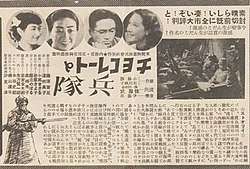Chocolate and Soldiers
Chocolate and Soldiers (チョコレートと兵隊, Chokorēto to Heitai) is a 1938 Japanese war film directed by Sato Takeshi. It shows the common Japanese soldier as an individual and as a family man, presenting even enemy Chinese soldiers as brave individuals. It is considered to be a "humanist" film, paying close attention to the human feelings of both the soldier and his family.[1]
| Chocolate and Soldiers | |
|---|---|
 Original publicity sheet, 1938 | |
| Directed by | Sato Takeshi |
| Produced by | Teppei Himuro |
| Written by | Akiko Ishikawa Masaru Kobayashi Noriko Suzuki |
| Starring | Kamatari Fujiwara Kiyoshi Hosoi Yuko Ichinose |
| Music by | Noboru Itô |
| Cinematography | Kyoji Yoshino |
Release date | 30 November 1938 |
| Country | Japan |
| Language | Japanese |
Plot
A hard-working father is called up and sent to the front. He keeps in touch with his family by writing letters home. These include chocolate wrappers collected from his comrades; his son is collecting the wrappers to redeem for a free box of chocolate. The man volunteers for one brave act, joining a suicide squad. Before he goes, he drinks a toast from a cup given him by his son, and (as happens in other "humanist" films) smiles to indicate his intention to die with his comrades. The son receives the news of his father's death at the same time as the free chocolates arrive. He swears vengeance; the chocolate company gives him a scholarship.[1]
Reception
The American director Frank Capra said of Chocolate and Soldiers "We can't beat this kind of thing. We make a film like that maybe once in a decade. We haven't got the actors."[2] The film opened the Japan Society's series of Japanese Second World War movies shown in the United States in 1987.[2]
Cinema theorist Kate Taylor-Jones suggests that along with films like Mud and Soldiers and The Legend of Tank Commander Nishizumi, Chocolate and Soldiers provided "a vision of the noble, obedient and honourable Japanese army fighting to defend the emperor and Japan."[3]
Joseph L. Anderson observes that the film was "obviously aimed at the home audience".[4]
References
- High, Peter B. (January 2003). The Imperial Screen: Japanese Film Culture in the Fifteen Years' War, 1931-1945. Univ of Wisconsin Press. pp. 217–218. ISBN 978-0-299-18134-5.
- Darnton, Nina (23 January 1987). "At the Movies". New York Times. Retrieved 13 March 2015.
- Taylor-Jones, Kate (16 July 2013). Rising Sun, Divided Land: Japanese and South Korean Filmmakers. Wallflower Press. p. 14. ISBN 978-0-231-16586-0.
- Anderson, Joseph L. (1982). The Japanese Film: Art and Industry. Princeton University Press. p. 131. ISBN 0-691-00792-6.